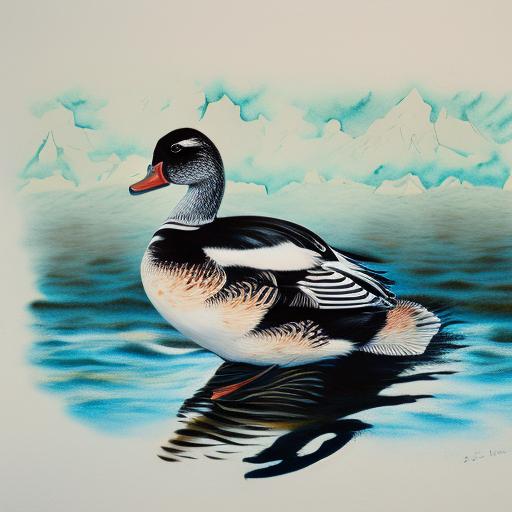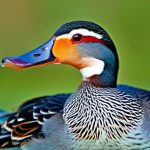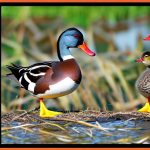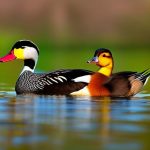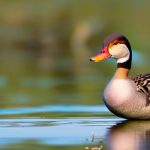Alaska is home to a variety of black and white duck breeds, each with its own unique characteristics and history. These breeds are not only a beautiful addition to the Alaskan landscape, but they also play a crucial role in the state’s ecosystem. From the majestic Black Swedish to the striking Magpie, these ducks have captured the hearts of many Alaskans and have become an integral part of the state’s wildlife. In this article, we will explore the history, characteristics, behavior, conservation efforts, and the role of black and white duck breeds in Alaska’s ecosystem. Whether you are a duck enthusiast, a wildlife conservationist, or simply curious about these fascinating birds, this article will provide you with a comprehensive understanding of black and white duck breeds in Alaska.
Table of Contents
- History and Origin of Black and White Duck Breeds
- Characteristics and Physical Appearance of Black and White Duck Breeds
- Behavior and Habitat of Black and White Duck Breeds in Alaska
- Conservation and Protection Efforts for Black and White Duck Breeds
- Role of Black and White Duck Breeds in Alaska’s Ecosystem
- Keeping and Raising Black and White Duck Breeds in Alaska
- FAQs
- What are some black and white duck breeds commonly found in Alaska?
- What are the characteristics of black and white duck breeds?
- Are black and white duck breeds good for egg production?
- What is the temperament of black and white duck breeds?
- What are some considerations for raising black and white duck breeds in Alaska?
Key Takeaways
- Black and white duck breeds are popular in Alaska for their unique characteristics and adaptability to the cold climate.
- These duck breeds have a long history and are believed to have originated from various parts of the world, including Asia and Europe.
- Black and white duck breeds are known for their striking physical appearance, with distinct color patterns and feather markings.
- In Alaska, these duck breeds exhibit a range of behaviors and can be found in various habitats, including wetlands, lakes, and rivers.
- Conservation efforts are in place to protect and preserve black and white duck breeds, as they play a crucial role in maintaining the ecological balance in Alaska.
History and Origin of Black and White Duck Breeds
The history of black and white duck breeds in Alaska dates back to the early days of European settlement in the region. Many of these breeds were brought to Alaska by early settlers who recognized the value of these ducks for their meat, eggs, and down. The Black Swedish, for example, is believed to have originated in Sweden and was brought to Alaska by Scandinavian immigrants in the late 19th century. Similarly, the Magpie duck, known for its distinctive black and white plumage, has its origins in the United States and was introduced to Alaska as a domestic breed. Over the years, these ducks have adapted to the harsh Alaskan climate and have become an integral part of the state’s wildlife. Today, black and white duck breeds can be found in various habitats across Alaska, from coastal wetlands to inland lakes and rivers.
Characteristics and Physical Appearance of Black and White Duck Breeds
Black and white duck breeds in Alaska are known for their striking plumage and distinctive physical characteristics. The Black Swedish, for example, is a large duck with a black plumage and a white bib that extends from its chest to its belly. Its legs are a bright orange color, and it has a broad, rounded head with a prominent bill. The Magpie duck, on the other hand, is known for its black and white pied plumage, with a black head and neck and a white body. It has a medium-sized body with a slightly upright stance and a bill that is yellow with a black bean at the base. Both of these breeds are known for their calm and friendly demeanor, making them popular choices for backyard flocks and small farms in Alaska.
In addition to their physical appearance, black and white duck breeds are also valued for their egg-laying abilities and meat quality. The Black Swedish is known for its large white eggs, which are prized for their rich flavor and high nutritional value. The Magpie duck, on the other hand, is valued for its excellent meat quality, with a tender texture and a rich flavor that is sought after by many Alaskan chefs. These ducks are also known for their hardiness and adaptability to cold climates, making them well-suited for the harsh Alaskan winters.
Behavior and Habitat of Black and White Duck Breeds in Alaska
Black and white duck breeds in Alaska are known for their adaptability to a wide range of habitats, from coastal marshes to inland lakes and rivers. They are often found in wetland areas where they can forage for food such as aquatic plants, insects, and small fish. These ducks are also known for their strong flying abilities, which allow them to migrate to different areas in search of food and suitable nesting sites. During the breeding season, black and white duck breeds will often build their nests in secluded areas near water, where they can lay their eggs and raise their young.
In terms of behavior, black and white duck breeds are known for their social nature and their ability to form strong bonds with other ducks. They are often seen in small flocks, where they will engage in activities such as preening, feeding, and resting together. These ducks are also known for their vocalizations, with different calls used to communicate with each other and to warn of potential threats. In addition to their social behavior, black and white duck breeds are also known for their strong maternal instincts, with females taking on the primary responsibility for incubating eggs and caring for their young.
Conservation and Protection Efforts for Black and White Duck Breeds
In recent years, there has been a growing awareness of the importance of conserving black and white duck breeds in Alaska. These ducks play a crucial role in the state’s ecosystem, helping to control insect populations, disperse seeds, and provide food for predators such as eagles and foxes. However, habitat loss, pollution, and hunting have posed significant threats to these ducks, leading to declines in their populations in some areas.
To address these challenges, conservation organizations in Alaska have been working to protect the habitats of black and white duck breeds and to raise awareness about the importance of conserving these birds. Efforts have been made to restore wetland areas, reduce pollution in waterways, and establish protected areas where these ducks can thrive. In addition, hunting regulations have been put in place to ensure that black and white duck populations remain sustainable and healthy.
Role of Black and White Duck Breeds in Alaska’s Ecosystem

Black and white duck breeds play a crucial role in Alaska’s ecosystem, contributing to the health and balance of wetland habitats. These ducks help to control insect populations by feeding on larvae and adult insects, which can help to reduce the spread of diseases such as West Nile virus. In addition, they also play a key role in dispersing seeds of aquatic plants, which helps to maintain the diversity of plant species in wetland areas.
Furthermore, black and white duck breeds provide an important food source for predators such as eagles, hawks, foxes, and mink. By preying on these ducks, predators help to maintain a healthy balance in the food chain and contribute to the overall health of the ecosystem. In addition, black and white duck breeds also contribute to the cultural heritage of Alaska, providing food, down feathers for insulation, and a source of recreation for hunters and wildlife enthusiasts.
Keeping and Raising Black and White Duck Breeds in Alaska
For those interested in keeping and raising black and white duck breeds in Alaska, there are several important considerations to keep in mind. First and foremost, it is essential to provide these ducks with a suitable habitat that includes access to water for swimming and foraging. Wetland areas or ponds with clean water are ideal for these ducks, as they require ample space to exhibit their natural behaviors.
In addition to providing suitable habitat, it is also important to ensure that black and white duck breeds have access to a balanced diet that includes a mix of grains, greens, insects, and aquatic plants. These ducks are omnivorous by nature and will thrive on a diverse diet that mimics their natural foraging habits.
Finally, it is important to consider the social nature of black and white duck breeds when keeping them in captivity. These ducks thrive in small flocks where they can interact with each other and engage in social behaviors such as preening and resting together. Providing ample space for these ducks to move around freely will help to ensure their well-being and happiness in captivity.
In conclusion, black and white duck breeds are an important part of Alaska’s wildlife heritage, contributing to the state’s ecosystem through their unique behaviors and characteristics. By understanding the history, characteristics, behavior, conservation efforts, and role of these ducks in Alaska’s ecosystem, we can work together to ensure that these beautiful birds continue to thrive for generations to come. Whether you are a wildlife enthusiast or someone interested in raising ducks in Alaska, these birds offer a fascinating glimpse into the natural world and provide valuable contributions to the state’s rich biodiversity.
If you’re interested in raising black and white duck breeds in Alaska, you might also want to check out this article on creating the perfect farmhouse chicken coop on PoultryWizard. It offers valuable insights into designing a comfortable and functional space for your poultry, which can be beneficial for both ducks and chickens.
FAQs
What are some black and white duck breeds commonly found in Alaska?
Some black and white duck breeds commonly found in Alaska include the Magpie duck, the Cayuga duck, and the Swedish duck. These breeds are known for their distinctive black and white plumage.
What are the characteristics of black and white duck breeds?
Black and white duck breeds typically have a striking appearance with a combination of black and white feathers. They are known for their hardiness and adaptability to cold climates, making them well-suited for the Alaskan environment.
Are black and white duck breeds good for egg production?
Yes, black and white duck breeds are known for their good egg production. They are reliable layers and can provide a steady supply of eggs, making them a popular choice for backyard poultry enthusiasts in Alaska.
What is the temperament of black and white duck breeds?
Black and white duck breeds are generally known to have calm and friendly temperaments. They are often docile and easy to handle, making them suitable for both small-scale and commercial duck farming operations in Alaska.
What are some considerations for raising black and white duck breeds in Alaska?
When raising black and white duck breeds in Alaska, it is important to provide them with adequate shelter and protection from the cold weather. Additionally, ensuring access to clean water and a balanced diet is essential for their health and well-being. Regular veterinary care and predator-proofing their housing are also important considerations.
Meet Walter, the feathered-friend fanatic of Florida! Nestled in the sunshine state, Walter struts through life with his feathered companions, clucking his way to happiness. With a coop that’s fancier than a five-star hotel, he’s the Don Juan of the chicken world. When he’s not teaching his hens to do the cha-cha, you’ll find him in a heated debate with his prized rooster, Sir Clucks-a-Lot. Walter’s poultry passion is no yolk; he’s the sunny-side-up guy you never knew you needed in your flock of friends!

